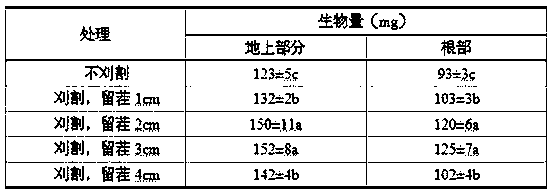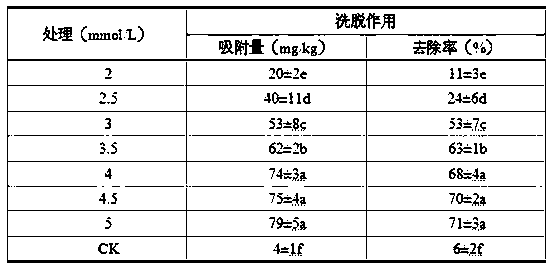Strengthening method for remedying soil contaminated by metal strontium through ryegrass and application
A technology for polluted soil and ryegrass is applied in the field of strengthening ryegrass to remediate strontium metal-contaminated soils, which can solve problems such as restricting agricultural and animal husbandry production and social and economic development, and achieve the effects of improving the remediation of heavy metal-contaminated soils, with simple technology and wide sources.
- Summary
- Abstract
- Description
- Claims
- Application Information
AI Technical Summary
Problems solved by technology
Method used
Image
Examples
Embodiment 1
[0019] A method for strengthening ryegrass to restore metal strontium-contaminated soil, comprising the following steps:
[0020] 1) Add metal strontium solution 100 mg / kg to the soil, mix evenly into the soil, and age for 2 weeks;
[0021] 2) Prepare saponin into a solution with a concentration of 2-5 mmol / L;
[0022] 3) The saponin solution in step 2) is added to the soil prepared in 1);
[0023] 4) Cultivate for 30 days, and measure the elution effect of different concentrations of saponin on the metal strontium in the soil.
[0024] Table 1 The effect of different concentrations of saponin on the elution of metal strontium in soil
[0025]
[0026] Note: Different letters in the same column indicate significant differences between treatments ( P <0.05). Same below
[0027] Table 1 shows the adsorption capacity and removal rate of metal strontium in the soil with different concentrations of saponin. It can be seen from Table 1 that after the application of 4-5mmol / ...
Embodiment 2
[0029] A method for strengthening ryegrass to restore metal strontium-contaminated soil, comprising the following steps:
[0030] 1) Rinse the ryegrass seeds after disinfection with 0.5% hypochlorous acid;
[0031] 2) Put the seeds in step 1) into a petri dish with nutrient solution to germinate for 3 to 5 days and then transplant them into strontium-contaminated soil;
[0032] 3) Divide the ryegrass in step 2) into two groups;
[0033] 4) A group of ryegrass in step 2) is not applied with mowing measures;
[0034] 5) The other group of ryegrass in step 2) was mowed after 45 days of growth, the stubble height was 1-4 cm, and continued to grow to 90 days;
[0035] 6) The ryegrass in step 4) and step 5 continued to grow until 90 days, and the ryegrass was harvested. Determination of aboveground and root biomass of ryegrass.
[0036] Table 2 Biomass of ryegrass with different cutting measures
[0037]
[0038] It can be seen from Table 2 that the biomass of ryegrass incre...
Embodiment 3
[0040] A method for strengthening ryegrass to restore metal strontium-contaminated soil, comprising the following steps:
[0041] Weigh 4kg soil sample (air-dried soil), and add metal strontium concentration of 100 mg / kg. After mixing evenly, put it into a plastic basin (the diameter of the wide mouth is 20cm, the diameter of the narrow mouth is 15cm, and the height is 10cm). Aging treatment for 2 weeks. Add tap water to about field water holding capacity, sow after overnight, 30 grains of ryegrass per pot, cover with soil about 2cm after sowing. After emergence, keep 20 seedlings with basically the same growth. Place the pot in a greenhouse and water regularly. The ryegrass was grown for 45 days to take mowing measures, and the stubble height was 2 cm. After the ryegrass continued to grow for 38 days, 4 mmol / L, 4.5 mmol / L, and 5 mmol / L of saponin were added to the soil around the root system, and five parallel experiments were set up. After continuing to grow for 7 days, ...
PUM
 Login to View More
Login to View More Abstract
Description
Claims
Application Information
 Login to View More
Login to View More - R&D
- Intellectual Property
- Life Sciences
- Materials
- Tech Scout
- Unparalleled Data Quality
- Higher Quality Content
- 60% Fewer Hallucinations
Browse by: Latest US Patents, China's latest patents, Technical Efficacy Thesaurus, Application Domain, Technology Topic, Popular Technical Reports.
© 2025 PatSnap. All rights reserved.Legal|Privacy policy|Modern Slavery Act Transparency Statement|Sitemap|About US| Contact US: help@patsnap.com



